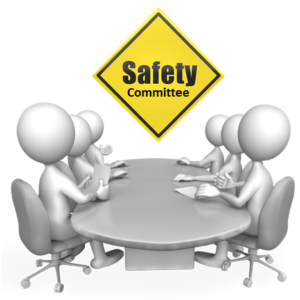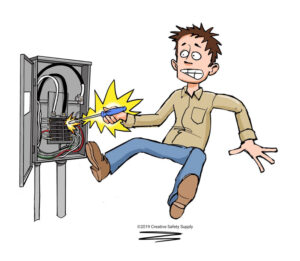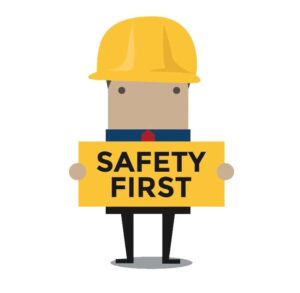
Safety News

Electrical Safety
 The hazards associated with electricity affect the majority of workplaces. Whether you are in general industry, construction, or even farming- electrical hazards are present. It is important to be able to recognize the electrical hazards around you and know how to mitigate them.
The hazards associated with electricity affect the majority of workplaces. Whether you are in general industry, construction, or even farming- electrical hazards are present. It is important to be able to recognize the electrical hazards around you and know how to mitigate them.
Electricity Related Injuries
According to Electrical Safety Foundation International, between 1992 and 2010 there were 5,096 fatalities in the United States due to contact with electricity. There were a total of 66,748 injuries that required days away from work in the same time period due to electricity. The construction industry experiences the majority of injuries and fatalities due to electricity. These statistics do not include injuries caused by secondary events. For example, an individual falling from a ladder due to getting shocked. If these types of injuries were included the statistics would be higher.
 Also, everyday there are workers who suffer some type of shock, but do not seek or require treatment for their injuries. Because of this, it is difficult to fully track the occurrence of electrical shock in the workplace.
Also, everyday there are workers who suffer some type of shock, but do not seek or require treatment for their injuries. Because of this, it is difficult to fully track the occurrence of electrical shock in the workplace.
Common Electrical Hazards
– Overhead Powerlines
– Underground Powerlines
– Lightning
– Faulty Equipment
– Working on Energized Equipment
– Improper Grounding
– Damaged Insulation
Electrical Safety Tips
- Maintain at least a 10 foot distance from 50kV overhead powerlines, add more distance as the voltage increases. Also avoid the poles themselves to avoid bringing lines to the ground.
- Call your local 811 utility locator prior to digging to avoid unexpectedly striking an underground electrical line or any other utility.
- Inspect all cords for damaged insulation or missing ground prongs. If either of these conditions exist get them fixed by a professional or remove them from use.
- Never work on energized equipment. Always follow proper lock and tag out procedures before performing electrical work. Test the power after locking and tagging out to ensure there is no power being fed to what you are working on.
- Do not operate electrical equipment in wet conditions. Also avoid having electrical components in a wet environment unless they are protected.
- Secure all electrical boxes and panels. Ensure components in and around these panels are in good working condition and not missing.
Summary
There are many different electrical hazards in any one workplace. It is important to understand electrical safety and respect the dangers electricity poses. Eliminate any electrical hazards in your work area to avoid an injury to yourself or another coworker.
Attitude & Safety
How does attitude affect how your work and safety on the job? What is your attitude today? We all have days where our overall attitude could improve, but how is yours towards your coworkers, boss, or safety on a day-to-day basis? If you are generally a negative person, what effects would a more positive attitude have on your life and on your work?
We all have days where our overall attitude could improve, but how is yours towards your coworkers, boss, or safety on a day-to-day basis? If you are generally a negative person, what effects would a more positive attitude have on your life and on your work?
A Positive Attitude & Health
There are many reasons to strive to have a positive attitude. Outside of the obvious reasons, such as improving your mood and being more enjoyable to be around, researchers have been studying how it can benefit our health. The Mayo Clinic mentions possible benefits such as:
- Increased life span
- Lower rates of depression
- Lower levels of distress
- Greater resistance to the common cold
- Better psychological and physical well-being
- Reduced risk of death from cardiovascular disease
- Better coping skills during hardships and times of stress
Attitude & Safety on the Job
A negative attitude can lead to carelessness, complacency, taking shortcuts, or even serve as a distraction from a work task. A negative attitude towards safety specifically will eventually result in unsafe behaviors. Unsafe behaviors lead to incidents occurring on the job resulting in injury or property damage. Is your overall attitude as it relates to safety negative? If so, why is that?
How to Improve Your Attitude
Recognize it. The first step to improve it is to recognize if it is leaning towards the negative side. Ask yourself how your attitude is today and why it is in that state. If it is negative then you need to try to improve it to be a safer, more efficient worker.
What is the source of the issue(s)? After you recognize the state of your attitude you need to find the source of your issues that are making it negative. What is bothering you? Is it a coworker? A family situation? Whatever it may be, take note of the negative sources.
Address the issues. Take the time to address what is having a negative effect on your attitude. For example, if it is an issue with a coworker or boss, have a conversation with them. Most issues can be resolved with a constructive conversation. If the issue cannot be resolved with a conversation with the other person, go to another level of management to resolve it.
Remain aware of your attitude. It is important to do a daily self-check. A good way to do this is to monitor your thoughts or conversations you are having with others. If you are having more negative conversations than positive ones, then it is a good indicator that you need to improve your attitude. It is easy for your attitude to begin to tip towards the negative side as stressors pile back on in your life. There is always going to be issues in your life, but it is important to not let them have a negative effect on you for an extended amount of time.

HEAT STRESS IS NOT COOL!
 Fire up your brain with this word puzzle to help remind you of tips for working safely in the summer heat.
Fire up your brain with this word puzzle to help remind you of tips for working safely in the summer heat.
WORD BANK:
| Electrolytes | Cramps | Caffeine | Sports Drinks |
| Water | Dehydration | Urine | Sunscreen |
| Clothing | Breaks | Heat Stroke | Medications |
- This is the best type of beverage to consume when working in hot temperatures:
- These OTC/prescription items could make you more susceptible to heat stress:
- Wearing light weight & loose fitting versions of this can help you keep cool:
- This happens when your body releases more fluid through sweating or urination than it takes in:
- For every one of these you consume, you should drink 3-4 bottles of water:
- Taking these frequently in a shaded or cool area can help your body cool off:
- Sports drinks & pickle juice are good sources of this & can help with dehydration:
- Beverages with this ingredient are dehydrating & can increase your risk of heat illness:
- Wearing this can help protect the largest organ of your body from the harmful effects of the sun:
- When this is light yellow, you’re well hydrated. If it’s dark yellow, you’re dehydrated & need water:
- Dehydration can cause this early symptom of heat illness:
- Hot/dry skin, chills, dizziness & loss of consciousness are symptoms of this & require an immediate call to 911:
Want the answers? Go check them out on our Newsletter page!
